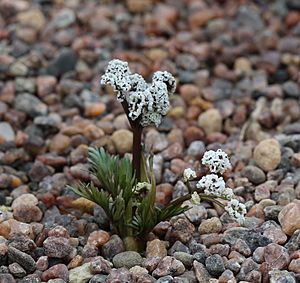Lomatium gormanii facts for kids
Quick facts for kids Lomatium gormanii |
|
|---|---|
 |
|
| Scientific classification | |
| Kingdom: | |
| (unranked): | |
| (unranked): | |
| (unranked): | |
| Order: | |
| Family: | |
| Tribe: |
Selineae
|
| Genus: | |
| Species: |
Lomatium gormanii
|
| Binomial name | |
| Lomatium gormanii (Howell) Coult. & Rose
|
|
Gorman's biscuitroot (scientific name: Lomatium gormanii) is a type of plant that grows back year after year. It's a perennial herb and belongs to the carrot family, known as Apiaceae.
This plant is special because it only grows in a specific area. It is found only in the Northwestern United States, in states like Idaho, Oregon, and Washington (state). The Sahaptin people, who are Native Americans from this region, have several names for it, including sasamít̓a, sasamít̓aya, and łałamít̓a.
About Gorman's Biscuitroot
Gorman's biscuitroot is a type of plant that comes back to life each spring without needing to be replanted. It's not a tree or a bush, but a smaller plant with soft stems. It's part of a big plant family that includes common vegetables like carrots, celery, and parsley.
Where Gorman's Biscuitroot Grows
This plant is endemic to the Pacific Northwest. This means it naturally grows only in this part of the world and nowhere else. You can find it in the wild areas of Idaho, Oregon, and Washington state. It's a native plant that is well-suited to the climate and soil of these regions.
How to Identify Gorman's Biscuitroot
Gorman's biscuitroot can sometimes look a lot like another plant called Lomatium piperi. However, there are a few ways to tell them apart. Gorman's biscuitroot usually has roots that are bigger and look "hairier." This means they have many more small rootlets attached to them. Also, it tends to grow in different places than L. piperi, which helps scientists and plant enthusiasts tell them apart.

